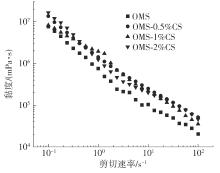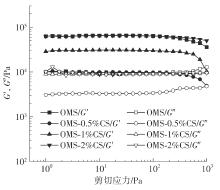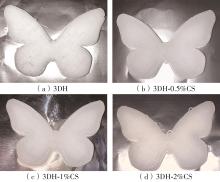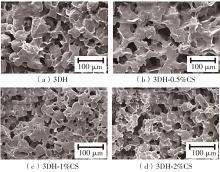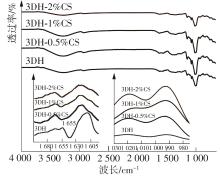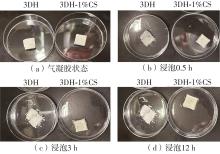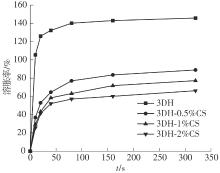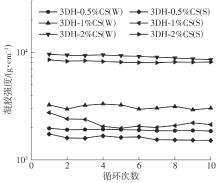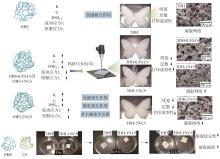Journal of South China University of Technology(Natural Science Edition) ›› 2024, Vol. 52 ›› Issue (3): 1-9.doi: 10.12141/j.issn.1000-565X.230433
• Materials Science & Technology • Previous Articles Next Articles
Effect of Chitosan on the Hot-Extrusion 3D Printing Formability of Oxidized Starch Gel
CHEN Ling LÜ Jiayu QIU Zhipeng
- School of Food Science and Engineering/Guangdong Province Key Laboratory for Green Processing of Natural Products and Product Safety/Engineering Research Center of Starch and Vegetable Protein Processing of the Ministry of Education,South China University of Technology,Guangzhou 510640,Guangdong,China
-
Received:2023-06-21Online:2024-03-25Published:2023-08-18 -
Contact:邱志鹏(1996-),男,博士生,主要从事淀粉功能化修饰研究。 E-mail:fesolorway@mail.scut.edu.cn -
About author:陈玲(1961-),女,博士,教授,博士生导师,主要从事淀粉功能化修饰与营养调控研究。E-mail:felchen@scut.edu.cn -
Supported by:the National Natural Science Foundation of China(32372276,32172167)
CLC Number:
Cite this article
CHEN Ling, LÜ Jiayu, QIU Zhipeng. Effect of Chitosan on the Hot-Extrusion 3D Printing Formability of Oxidized Starch Gel[J]. Journal of South China University of Technology(Natural Science Edition), 2024, 52(3): 1-9.
share this article
Table 2
Change of G' during alternate strains sweep experiments for oxidized starch and its composite gel material with CS"
| 样品 | G | G | G | G | G | DSR3-1/% | DSR5-3/% |
|---|---|---|---|---|---|---|---|
| 3DH | 75 947±153a | 1 203±43a | 18 472.0±101a | 885±1a | 13 718±113a | 24.32±0.08a | 74.26±0.06c |
| 3DH-0.5%CS | 25 638±113d | 510±23b | 6 054.3± 82c | 339±2c | 4 699±53d | 23.61±0.04a | 77.62±0.03b |
| 3DH-1%CS | 30 119±120c | 663±12b | 6 815.5± 75c | 436±2b | 5 465±41c | 22.63±0.03a | 80.19±0.03a |
| 3DH-2%CS | 53 472±114b | 1 196±25a | 9 871.8± 86b | 779±3a | 7 063±56b | 18.46±0.04b | 71.55±0.04d |
Table 5
Gel strength parameters of oxidized starch and its composite gel material with CS"
| 样品 | 破断力/g | 破断距离/cm | 凝胶强度/ (g·cm-1) |
|---|---|---|---|
| 3DH(W) 2) | 32.33± 1.34e | 0.18±0.01b | 179.61± 7.27d |
| 3DH-0.5%CS(W) 2) | 353.82± 6.36d | 0.18±0.01b | 1 965.66± 35.33c |
| 3DH-0.5%CS(S) 3) | 316.57± 4.35d | 0.18±0.01b | 1 758.72± 24.16c |
| 3DH-1%CS(W) 2) | 471.47± 7.87c | 0.14±0.03c | 3 367.64± 56.21b |
| 3DH-1%CS(S) 3) | 568.45± 8.32c | 0.19±0.01a | 2 991.84± 43.79b |
| 3DH-2%CS(W) 2) | 1 240.61±60.48b | 0.13±0.02c | 9 543.15±465.23a |
| 3DH-2%CS(S) 3) | 1 642.80±40.86a | 0.19±0.02a | 8 646.21±215.05a |
| 1 | PUSHPAMALAR J, MEGANATHAN P, TAN H L,et al .Development of a polysaccharide-based hydrogel drug delivery system (DDS):an update[J].Gels,2021,7(4):153/1-22. |
| 2 | RADULESCU D M, NEACSU I A, GRUMEZESCU A M,et al .New insights of scaffolds based on hydrogels in tissue engineering[J].Polymers,2022,14(4):799/1-30. |
| 3 | SHI Y, ZHANG M, BHANDARI B .Effect of addition of beeswax based oleogel on 3D printing of potato starch-protein system[J].Food Structure,2021,27(1):100176/1-10. |
| 4 | CHEN H, XIE F, CHEN L,et al .Effect of rheological properties of potato,rice and corn starches on their hot-extrusion 3D printing behaviors[J].Journal of Food Engineering,2019,244:150-158. |
| 5 | 陈玲,杜安林,唐煜括,等 .不同糊化度淀粉材料结构演变对其热挤压3D打印成型性的影响[J].华南理工大学学报(自然科学版),2021,49(3):62-70,87. |
| CHEN Ling, DU Anlin, TANG Yukuo,et al .Effects of structural evolution of starch materials with different gelatinization degrees on materials’ printability of hot-extrusion 3D printing[J].Journal of South China University of Technology(Natural Science Edition),2021,49(3):62-70,87. | |
| 6 | ZHANG J, LI Y, CAI Y,et al .Hot extrusion 3D printing technologies based on starchy food:A review[J].Carbohydrate Polymers,2022,294:119763/1-12. |
| 7 | ZHU W, MA X, GOU M,et al .3D printing of functional biomaterials for tissue engineering[J].Current Opinion in Biotechnology,2016,40:103-112. |
| 8 | CHAUNIER L, GUESSASMA S, BELHABIB S,et al .Material extrusion of plant biopolymers:opportunities & challenges for 3D printing[J].Additive Manufacturing,2018,21:220-233. |
| 9 | WANG Y J, WANG L .Physicochemical properties of common and waxy corn starches oxidized by different levels of sodium hypochlorite[J].Carbohydrate Polymers,2003,52(3):207-217. |
| 10 | WANG W, MENG Q, LI Q,et al .Chitosan derivatives and their application in biomedicine[J].International Journal of Molecular Sciences,2020,21(2):487/1-26. |
| 11 | QING L, NA J, LIU X,et al .Rapid gelling,self-healing,and fluorescence-responsive chitosan hydrogels formed by dynamic covalent crosslinking[J].Carbohydrate Polymers,2020,246:116586/1-10. |
| 12 | SHAGHAYEGH A, POURIA S, ELAHEH A,et al .Chitosan/dialdehyde starch hybrid in situ forming hydrogel for ocular delivery of betamethasone[J].Materials Today Communications,2022,33:104873/1-9. |
| 13 | JI Y, LIN X, YU J .Preparation and characterization of oxidized starch-chitosan complexes for adsorption of procyanidins[J].LWT,2020,117:108610/1-6. |
| 14 | LIU Y, CHEN L, XU H,et al .Understanding the digestibility of rice starch-gallic acid complexes formed by high pressure homogenization[J].International Journal of Biological Macromolecules,2019,134:856-863. |
| 15 | NAUREEN B, MIANA G A, SHAHID K,et al .Iron (Ⅲ) and zinc (Ⅱ) monodentate Schiff base metal complexes:synthesis,characterisation and biological activities[J].Journal of Molecular Structure,2021,1231:129946/1-12. |
| 16 | QIU Z, ZHENG B, XU J,et al .3D-printing of oxidized starch-based hydrogels with superior hydration properties[J].Carbohydrate Polymers,2022,292:119686/1-9. |
| [1] | ZHAO Zhengang LIU Shuang YOU Lijun. Preparation of Chitosan Coated Liposome Loaded Betanin and Its Antitumor Activity [J]. Journal of South China University of Technology (Natural Science Edition), 2022, 50(1): 16-22. |
| [2] | CHEN Ling, DU Anlin, TANG Yukuo, et al. Effects of Structural Evolution of Starch Materials with Different Gelatinization Degrees on Materials' Printability of Hot-Extrusion 3D Printing [J]. Journal of South China University of Technology(Natural Science Edition), 2021, 49(3): 62-70,87. |
| [3] | ZHAO Zhengang HAN Dexia. Adsorption of Humic Acid in Water by Activating Carbon-Attached Chitosan [J]. Journal of South China University of Technology(Natural Science Edition), 2018, 46(10): 141-148. |
| [4] | PENG Xin-wen TAN Jie-wen WU Chang-yan DENG Qing LIN Jia-chun SUN Run-cang. reparation and Catalysis Performance of Hemicelluloses-g- Chitosan-Pd(0) Catalyst [J]. Journal of South China University of Technology (Natural Science Edition), 2016, 44(6): 27-34,40. |
| [5] | Yuan Yi-hua Lei Li He Hui Jia De-min. Study on the Adsorption of Copper Ions by Epichlorohydrin-Crosslinked Chitosan /Sodium Alginate Adsorbent [J]. Journal of South China University of Technology(Natural Science Edition), 2012, 40(7): 148-154. |
| [6] | Zhou Jian-qin Chen Shao-hua. Extraction of Active Components from Plants Using Cellulase Immobilized on an Intelligent Gel Support [J]. Journal of South China University of Technology(Natural Science Edition), 2012, 40(1): 125-130,137. |
| [7] | Liu Kai He Bei-hai Li Xiao-min Zhao Guang-lei. Preparation of Modified Chitosan Microsphere and Its Adsorption Behavior for Poly-galacturonic Acid [J]. Journal of South China University of Technology (Natural Science Edition), 2011, 39(1): 74-78. |
| [8] | Wang Xiao-ying Liu Bo Sun Run-cang Wu Jun. Structure and Properties of Chitosan/Rectorite Nanocomposites [J]. Journal of South China University of Technology (Natural Science Edition), 2010, 38(9): 96-101. |
| [9] | Wang Xiao-ying Liu Bo Lin Lu Wu Jun Sun Run-cang. Investigation into Novel Nanocomposites as Non-Viral Gene Carrier [J]. Journal of South China University of Technology (Natural Science Edition), 2010, 38(5): 133-138. |
| [10] | Ge Hua-cai Huang Shi-ying Liang Kai . Microwave-Irradiated Preparation Modified Chitosan and Adsorption Property of Microsphere [J]. Journal of South China University of Technology (Natural Science Edition), 2009, 37(6): 27-30,36. |
| [11] | Duan Li-hong Yang Jin-qing Ye Sheng-quan Chen Song-wei Guo Si-yuan . Adsorption Properties of Chitosan Schiff Base for Cr( VI ) in Magnetic Field [J]. Journal of South China University of Technology (Natural Science Edition), 2009, 37(4): 130-133. |
| [12] | Jiang Yin Wang Zhao-mei Ye Sheng-quan Guo Hua Guo Si-yuan . Effects of Extrinsic Physical Fields on the Coordinated Reaction for Chitosan-Fe( Ⅱ ) [J]. Journal of South China University of Technology (Natural Science Edition), 2008, 36(7): 62-66,71. |
| [13] | Wang Ming-li Si Fang Zhang Yi-ming Zhao De-gang . Preparation and Mechanical Properties of Composite Chitosan/Nano-Sized SiOx Film [J]. Journal of South China University of Technology (Natural Science Edition), 2008, 36(7): 36-41. |
| [14] | LiLin Lin Jing-yun Li Jian-bin Chen Ling Li Bing Li Xiao-xi . Effect of Ultrasonic Treatment on Gel Properties of Potato Starch Paste [J]. Journal of South China University of Technology (Natural Science Edition), 2008, 36(11): 63-67. |
| [15] | Wang Ying-jun Zhao Xiao-fei Lu Ling Ren Li Chen Xiao-feng Ge Jian Liu Bing-qian. Performance of Chitosan-Collagen Blend M embrane as Cornea Tissue Engineering Scafold [J]. Journal of South China University of Technology (Natural Science Edition), 2006, 34(8): 1-5. |
| Viewed | ||||||
|
Full text |
|
|||||
|
Abstract |
|
|||||
